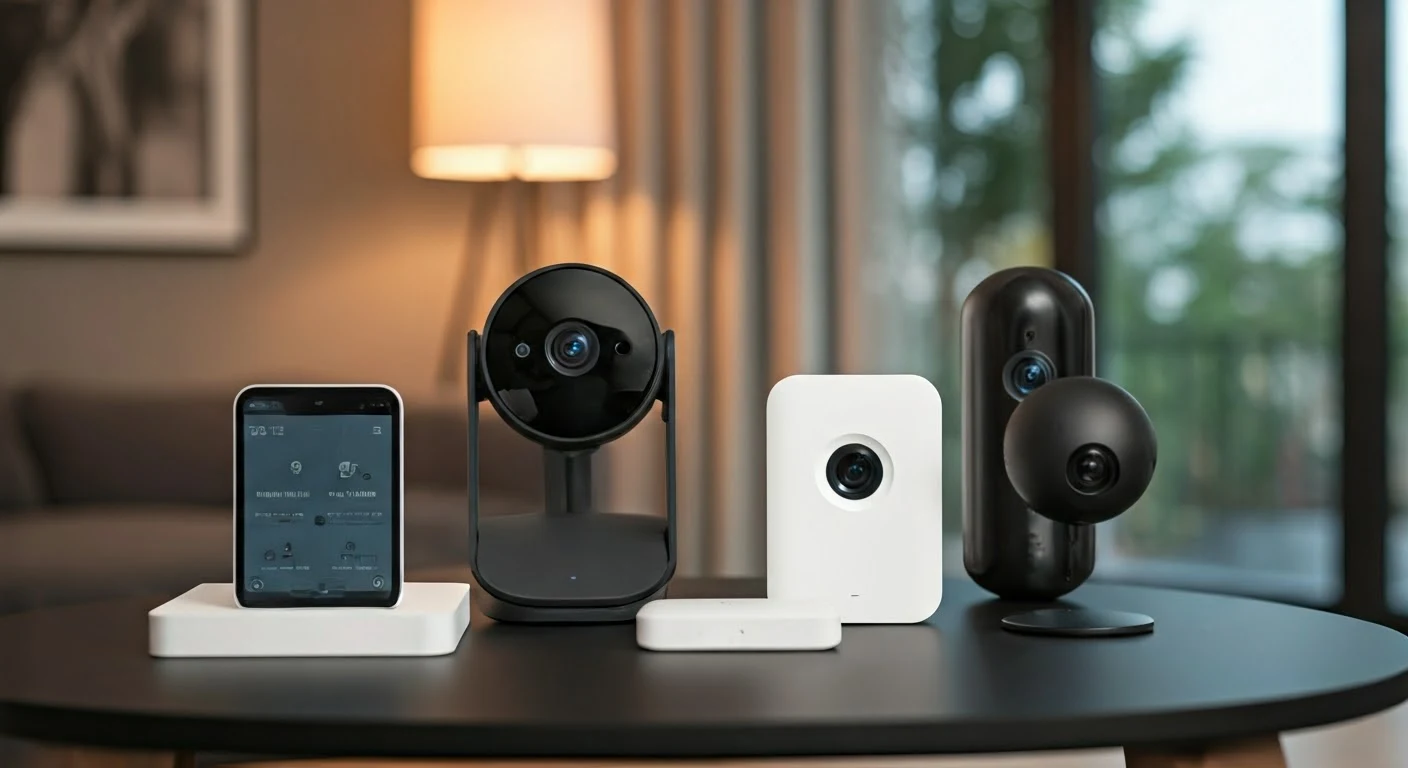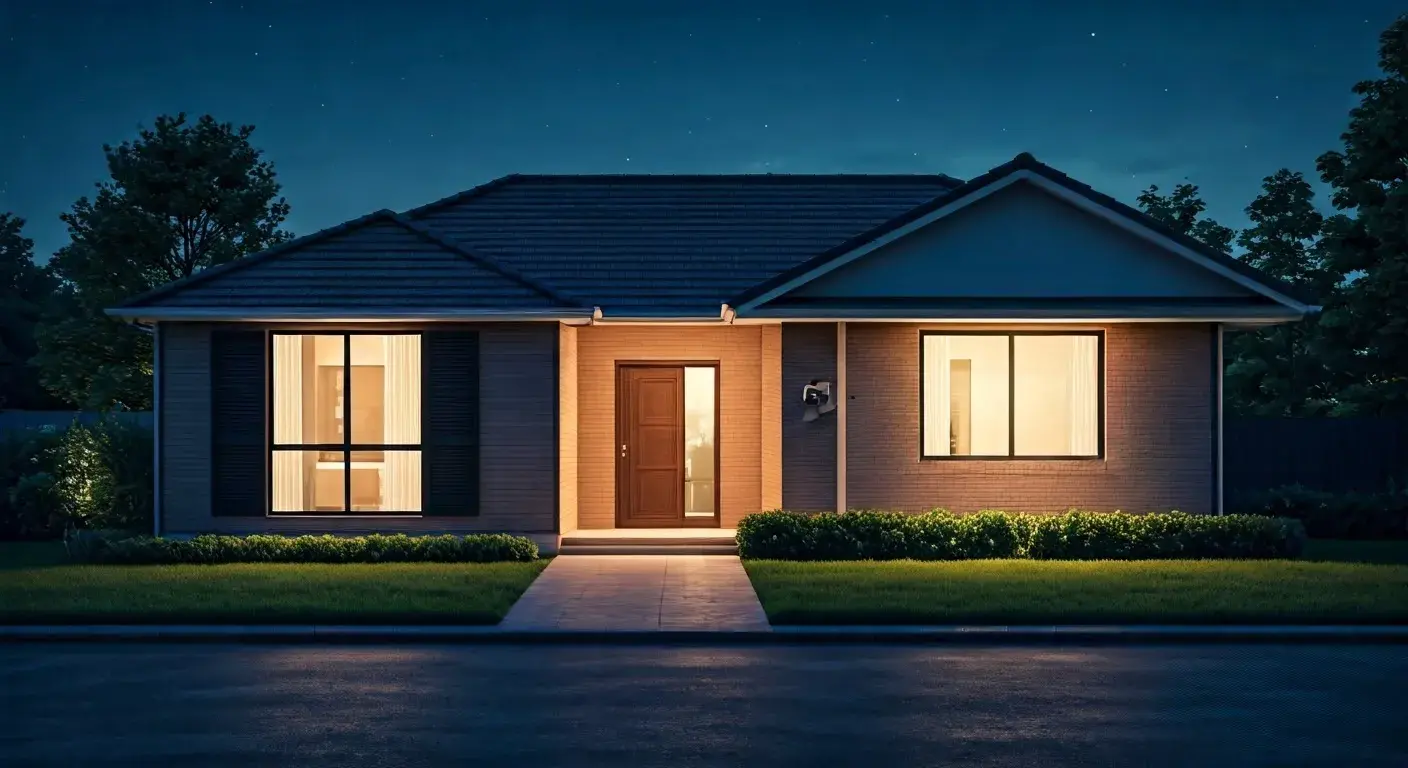In today’s world of smart homes and connected devices, many people want good home security that doesn't cost a lot. Luckily, new technologies have created home security systems that come with great features, and some are even free. This blog post will look at free smart home security systems in 2025. We will explore what they can do, their benefits, and how they can give you peace of mind.
Evaluating Free Smart Home Security Systems in 2025
The home security world is changing fast. This change comes from new technology and people wanting cheaper options. By 2025, we will see smart home security systems that are loaded with features and completely free. These systems change how we keep our homes and loved ones safe. They use the internet, wireless communication, and smart automation to give us safety and control which used to cost a lot.
We no longer need to depend on costly security systems that need professional installation and a monthly professional monitoring plan in addition to monthly fees. Free smart home security systems allow homeowners to manage their security without spending much money. However, with so many free options available, it’s important to check what they can and can't do. This way, you can choose the system that best fits your needs.
Criteria for Selection
When you look for free smart home security systems, you should keep a few important things in mind:
- Core Features: The system needs to have key features. These include motion detection, quick alerts, and the ability to watch remotely using a simple mobile app. It’s helpful if it works with your current smart home devices, like Google Home or Amazon Alexa.
- Video Capabilities: Choose systems that offer good video recording. It’s ideal to get one with night vision and options for local storage or free cloud storage. Some systems give you a little free cloud space but let you pay more for longer recording times.
- User Experience: The system needs to be simple to set up and use. A good mobile app with easy controls and alerts that you can change makes using it a better experience.
Importance of No-Cost Security in Today’s Economy
In a world with money worries, free security solutions are a great help for homeowners. Free smart home security systems make it easier for more people to protect their homes.
These systems are great for those on a tight budget, renters who don’t want to spend a lot on homes they do not own, and tech-savvy users who can set things up themselves.
When homeowners choose a free smart home security system, they can spend their money on other important things without losing safety at home. This way, they get peace of mind without having to pay monthly subscription fees.
Comprehensive Reviews of Top Free Smart Home Security Systems
This part will look closely at the best free smart home security systems available in 2025.
We will discuss their good and bad points based on real testing and what users say. We will cover topics like:
Overview of Leading Free Security Systems
The market for free smart home security systems has grown a lot. Several main options stand out:
- "Freemium" Model Systems: These systems give users basic features for free. You can pay a monthly or annual fee to unlock better features like more cloud storage, professional monitoring, or extra integrations. Some examples are Ring Alarm, SimpliSafe, and Arlo.
- Open-Source Systems: These systems allow for more customization. However, they need a bit more tech skills to set up and keep running. Some popular choices are Home Assistant and OpenHAB.
- Manufacturer-Specific Systems: Many manufacturers offer basic security features as part of their smart home products. For instance, Google Nest provides limited free video storage and event recording with its cameras.
Detailed Analysis of System Features and User Experience
We will look more closely at each system's main features and how they work in real life:
- Motion Detection Accuracy: Can the system tell the difference between real threats and false alarms, like pets or shadows?
- Alert Reliability: Are you getting alerts quickly and reliably, so you know about security issues in time?
- Mobile App Functionality: Is the mobile app easy to use and full of features? Can you arm or disarm the system easily, see live video, and change settings?
- Customer Support: What kind of help is offered for free users? Is there access to online resources, FAQs, or community forums for help?
The Rise of DIY Security Solutions
One big trend in home security is the growth of DIY solutions. Free smart home security systems have played a key role in pushing this trend forward.
Many factors are causing this move towards DIY security, such as:
Benefits of DIY Over Professional Installation
Choosing a DIY security system instead of a professional installation has many benefits:
- Cost Savings: This is the most obvious advantage. DIY systems do not have installation fees and let you avoid long contracts and extra costs.
- Flexibility and Control: With DIY, you can create a system that fits your home and your family's unique security needs. You can begin small and grow your system without being stuck with a set plan.
- Ease of Installation: Most DIY systems use wireless parts and easy-to-use mobile apps. This makes it simple for homeowners, even those with basic skills, to install the system.
Step-by-Step Guide to Setting Up Your System
Setting up a DIY smart home security system is typically easy:
- Choose Your System: Figure out what your home needs for security. Pick a free system that matches those needs.
- Plan Sensor and Camera Placement: Place sensors on doors, windows, and busy areas. Put cameras where they can see entry points and important items.
- Install the Hub and Components: Most systems work without wires for easier setup. Follow the instructions to connect devices to the main hub.
- Configure the System: Use the mobile app to change your settings, set motion zones, customize alerts, and make automation rules.
Advanced Features in Free Smart Home Security
Free systems usually begin with simple security features. However, as technology improves, the difference between free and paid services is getting less clear.
Now, many free smart home security systems provide features that were previously only found in expensive, paid options.
Integration with Smart Home Devices
Advanced free security systems work well with your smart home devices. This connection brings many benefits:
- Voice Control: You can easily arm or disarm your system with voice commands using Amazon Alexa or Google Assistant. This makes it simple and hands-free.
- Automated Routines: You can set up routines to automatically turn on lights when motion is detected or unlock smart locks if a smoke alarm goes off.
- Centralized Control: You can control your security system and other smart home devices from one app. This simplifies control and automation.
Innovative Security Technologies in 2025
The year 2025 introduces some exciting technologies in free smart home security systems:
- AI-Powered Facial Recognition: This technology helps to identify familiar faces. It makes security better and decreases false alarms by telling apart family, friends, and strangers.
- Enhanced Environmental Monitoring: Some systems now come with sensors to check for floods, fires, and carbon monoxide. These sensors offer safety that goes beyond just stopping intrusions.
- Predictive Analytics: These systems learn your daily habits. They can predict possible threats and adjust security settings before problems happen, which keeps you safer.
User Testimonials and Success Stories
Real-life stories show how free smart home security systems help people in their daily lives.
This section will share what users say and highlight stories of success, showing:
Real-Life Impact of Using Free Security Systems
These stories show how free smart home security systems have helped:
- Deterred Burglaries: See how motion-activated alerts helped scare off possible intruders. This kept homes and people safe.
- Peace of Mind for Families: Find out how families felt safer knowing their homes were protected, even when they were not there.
- Remote Monitoring for Elderly Relatives: Learn about people who used remote monitoring to check on their elderly family members and make sure they were okay.
How These Systems Have Enhanced Home Safety?
We’ll look at how these systems have improved home safety in big ways:
- Increased Awareness: Systems that send instant alerts help homeowners stay aware of what’s happening around their homes. This encourages them to take action to stay safe.
- Faster Response Times: Real-time alerts help people respond quickly to possible issues. This can reduce damage and increase the chances of catching the bad guys.
- Neighborhood Watch Enhancement: Some systems let neighbors talk to each other. This helps create a digital neighborhood watch, making the community safer for everyone.
Security System Maintenance and Updates
Keeping your free smart home security system working well is very important.
This part will give you useful tips on:
Keeping Your System Up-to-Date
Regular updates are important for your security system to work well:
- Software Updates: Make sure to install the latest software updates from the maker. These updates usually fix bugs, improve security, and boost performance.
- Device Firmware Updates: Keep all of your connected devices, like sensors, cameras, and the main hub, up to date with the latest firmware. This helps improve security and how well they work.
- Regularly Test the System: Test all parts of the system, like sensors, alarms, and cameras, from time to time. This helps ensure they are working correctly and talking to the hub as they should.
Troubleshooting Common Issues
Encountering problems with your security system can be annoying. This part will help you with solutions for common issues:
- Connectivity Issues: Find out how to fix Wi-Fi or network problems that can stop communication or remote access to your system.
- Sensor Malfunctions: Learn about common reasons for sensor problems. Discover how to troubleshoot and fix these issues to keep your system working well.
- Camera Issues: Solve problems with camera connectivity, video quality, and night vision to get the most out of your video surveillance.
Maximizing Your Security Setup
Strategic placement and extra security steps can greatly improve your home's safety.
This part will help you with:
Best Practices for Placement of Sensors and Cameras
The success of your security system depends a lot on where you place your sensors and cameras.
- Entry Point Coverage: Put sensors on all entry points, like doors, windows, and garage doors. This will help create a strong barrier.
- High-Traffic Area Monitoring: Install motion sensors in busy spots like hallways, stairwells, and living areas to catch any strange activity.
- Camera Coverage for Vulnerable Areas: Arrange cameras to watch over weak spots, such as entryways, driveways, and places where you keep valuable items.
Enhancing Security with Additional (Free) Tools
Enhancing your smart home security can be done by adding extra tools. You might think about using night vision cameras. They help you see better in low light. Look for a system that gives you free cloud video storage. This way, you can save video recordings without paying a monthly fee. Using motion detection technology can alert you right away to any strange activity. Also, choosing professional monitoring services means someone will keep an eye on your property all the time. Adding these tools to your current setup can give you full protection for your home and family.
Future Trends in Home Security Systems
The home security field is always changing. This change comes from new ideas and looking to the future.
This section gives information about:
Predictions for the Next Decade
Several trends are set to change home security systems in the future:
- Seamless AI Integration: We can expect smarter features like better facial recognition, behavior tracking, and early threat detection.
- Hyper-Personalization: Security systems will be more personalized. They will adjust to your routines and likes for a better security experience.
- Integrated Smart Home Ecosystems: Home security will work well with other smart home systems. This will make it easier to control everything in your connected home from one place.
Emerging Technologies to Watch
Keep a look out for these new technologies that can change home security:
- Drone Surveillance: Drones that fly on their own could watch over your property. This adds another level of safety and helps you see what's going on from above.
- Biometric Authentication: More places will likely use fingerprint scans, voice recognition, or even iris scans. These methods can help keep your access secure.
- Quantum Computing Security: Quantum computing may improve encryption methods. It can help protect against very advanced cyberattacks.
How to Choose the Right Free Security System for Your Home?
Choosing the right free security system means thinking about what you need and what’s most important to you.
Follow these steps to pick a system that offers complete protection:
Assessing Your Home’s Security Needs
Start by looking at what your home needs for security:
- Property Type: The kind of property you have, like a house, apartment, or condo, affects what you need for safety.
- Neighborhood Crime Rates: Check local crime rates and see what kinds of crimes happen in your area to help decide your security focus.
- Family Structure: Think about how many people live in your home, their ages, and any special security needs for young kids or older adults.
Comparing Different Systems’ Capabilities
Once you know what you need, look closely at what different free security systems can do:
| Feature | System A | System B | System C |
| Motion Detection | Yes | Yes | Yes |
| Video Recording Quality | 1080p | 720p | 1080p |
| Night Vision | Yes | Limited | Yes |
| Local Storage | microSD Card | Cloud Only | microSD Card & Cloud (Limited) |
| Smart Home Integration | Alexa, Google | Alexa Only | Alexa, Google, Apple |
The Role of AI and Machine Learning in Enhancing Home Security
Artificial intelligence and machine learning are quickly changing how smart home security systems work, even the free ones.
These technologies provide clever features that are made to:
Examples of AI in Action
Here are some clear examples of how AI is making home security better:
- Smart Motion Detection: This technology can tell the difference between people, animals, and objects. This helps to cut down on false alarms and gives you important alerts.
- Facial Recognition: It can recognize familiar faces at your door or in your home. This improves security and sends you personal notifications.
- Anomaly Detection: AI learns your usual patterns and routines. It sends you alerts if there is any unusual activity, like something happening at a strange hour.
The Future of AI in Home Security
The future of AI in home security is very promising:
- Predictive Security: AI can look at data from different places, such as weather trends and crime rates. This helps it guess possible dangers and change security settings before something happens.
- Personalized Threat Responses: Picture a system that changes its reaction to a threat. It does this based on your personal choices and what is happening at the moment.
- Continuous Learning and Improvement: AI systems will keep learning and getting better. Over time, they will provide protection that is more personalized and dependable.
The Importance of Cybersecurity in Smart Home Systems
As smart home systems get more advanced and connected, it's very important to keep them safe from cyber threats.
To protect your home network and security system from these dangers, you need to:
Protecting Your Home Network
Your home network is very important for keeping your smart security system safe. You can follow these steps to improve its security:
- Strong Passwords: Make sure you use different and strong passwords for your router, security system hub, and all connected devices. Don't use easy passwords or the same passwords for multiple accounts.
- Network Encryption: Turn on WPA2 or WPA3 encryption on your router. This will keep your Wi-Fi network secure and help protect the data sent between devices.
- Firmware Updates: Update your router's firmware often. This way, you can get the most recent security fixes and improvements.
Best Practices for Digital Security
In addition to keeping your network safe, these digital security tips can boost your protection:
- Two-Factor Authentication: Always turn on two-factor authentication (2FA) when you can. It gives you extra security along with your password.
- Regular Device Audits: Check often to see which devices are linked to your home network. Take away any devices that look strange or are not allowed.
- Beware of Phishing Attempts: Be careful with emails, messages, or calls that seem fishy and ask for your info or entrance to your security system.
Community Support and Resources for DIY Security
One great reason to pick a DIY smart home security system is the strong community support you can find online. If you need help with installation, fixing issues, or checking out new features, there are many people ready to assist you.
Online Forums and Help Centers
Online forums and help centers give a lot of useful information and support:
- Manufacturer Forums: Look at the manufacturer's website. There you can find official forums where users share tips, solutions, and support.
- DIY Security Communities: Check out online groups focused on DIY home security. Good options are Reddit forums or special websites.
- Online Help Centers: Many manufacturers have detailed online help centers. These often include FAQs, troubleshooting guides, and tutorials.
Leveraging Community Knowledge for Security Enhancements
The DIY security community is a great place to help you stay safe:
- Learn from Others: Get tips and stories from people who have used different systems or devices.
- Find New Features: Look into special features or ways to customize your system that you may not know about yet.
- Fix Problems Together: Use the community's shared knowledge to solve tricky problems or technical issues.
Cost-Saving Tips for Smart Home Security
You have already made a wise decision by choosing a free system. But did you know you can save more on smart home security and still keep your protection strong?
This part will share smart ways to:
How to Avoid Hidden Costs?
While free smart home security systems are a great way to save money, watch out for some hidden costs:
- Cloud Storage Fees: Some systems give you a little free cloud storage. But if you need more, you have to pay.
- Premium Feature Subscriptions: Be careful. Some cool features require you to buy a subscription, like advanced object detection or professional monitoring.
- Equipment Replacement Costs: Think about how much it might cost to replace batteries in sensors or cameras over time.
Budget-Friendly Security Hacks
Implement these affordable security tips to boost your protection without spending more money:
- Smart Lighting: Use timers or motion sensors for outdoor lights. This can help scare away possible intruders.
- Clear Security Signs: Put up signs for security systems where they can be seen, even if you have a DIY system. This acts as a strong warning.
- Neighborhood Watch Teamwork: Work with your neighbors to set up a neighborhood watch program. This will improve safety through shared awareness.
The Legal Aspect of Home Surveillance
As you start using your free smart home security system, it is very important to know about the legal issues, especially about privacy. This knowledge will help you use it responsibly.
This section will provide you with the information on:
Navigating Privacy Laws
Familiarize yourself with the privacy laws about home surveillance in your area:
- Recording Consent: Know the rules about recording audio or video on your property. In some places, you may need to ask for permission from anyone being recorded.
- Data Protection: Learn about the laws that protect personal data from your security system. This includes video footage and facial recognition data.
- Neighbor Notifications: In some areas, you may have to tell your neighbors if your cameras can see their property.
Ensuring Compliance with Local Regulations
Stay compliant with local rules for home security systems:
- Permit Requirements: Some places need you to get permits before installing security cameras or alarms. Check with your local authorities to follow the rules.
- Restrictions on Camera Placement: Keep in mind any rules about where you can place cameras, especially near public areas or your neighbor's property.
- Signage Requirements: Some areas require you to have certain signs if you have security cameras. Make sure your signs follow local laws.
Environmental Impact of Smart Home Security Systems
When thinking about home safety, it's also good to keep in mind how your smart home security system affects the environment. This is true even if you choose a free option.
This section looks at ways to:
Energy-Efficient Practices
Embrace these green habits to reduce your system’s energy use:
- Motion-Activated Sensors: Use motion-activated sensors for lights and security. They will only use power when necessary.
- Energy-Saving Settings: Check for energy-saving options in your system's mobile app. You can change the recording time or adjust motion sensitivity.
- Rechargeable Batteries: Pick security devices that have rechargeable batteries. This helps cut down battery waste. You can also choose devices with long battery life to lower replacements.
Sustainable Security Solutions
Support companies that care for the environment:
- Recyclable Materials: Pick products made from recycled or recyclable materials. This helps cut down on electronic waste.
- Energy Star Certified Devices: Check for security cameras and devices that have the Energy Star label. This shows they use energy wisely.
- Responsible Disposal: When you need to upgrade or change your system, make sure to recycle electronic parts properly through certified programs.
Personalization Options in Free Security Systems
The time when there was just one type of security solution for everyone is over.
Free smart home security systems now focus more on:
Customizable Alerts and Notifications
Personalized alerts help reduce alert fatigue. They let you focus on events that truly matter:
- Alert Types: You can customize the alerts you want. For example, choose from motion detection, door/window openings, or certain activity areas.
- Alert Delivery: Pick how you receive alerts. Options include push notifications, text messages, or email alerts.
- Alert Schedules: Set specific times for alerts. For example, you can turn off motion alerts during the day when you are home.
Tailoring Your System to Fit Your Lifestyle
Adjust the settings and automation rules of your system to fit your personal needs and way of life:
- Pet Modes: Set up pet modes so your pets do not set off false alarms.
- Geofencing: Use geofencing to automatically arm or disarm your system based on where you are.
- Custom Automation Rules: Make specific automation rules, like turning on certain lights or changing the thermostat when you get home.
Comparison With Paid Security Solutions
While we have talked about the good things about free smart home security systems, it’s important to know:
What You Gain with Free vs. Paid?
Here’s a side-by-side comparison:
| Feature | Free Systems | Paid Systems |
| Upfront Cost | Lower, often zero | Higher, may involve equipment and installation costs |
| Monthly Fees | None for basic functionalities; may offer premium subscriptions | Recurring monthly or annual fees for monitoring and additional features |
| Features | Basic to advanced features are often available; may offer premium features for a fee | A wider range of advanced features and integrations |
| Professional Monitoring | Usually not included; may offer as a paid add-on | Typically included or available as an option |
Making the Decision: Free vs. Paid Security Systems
The final choice depends on what you need and what is important to you:
- Budget: If you don’t have much money to spend, free systems can be very helpful. Think about the extra features and if they are worth the cost based on your needs.
- Technical Expertise: If you like to do things yourself and can set up and fix problems, you might enjoy the flexibility of free systems.
- Desired Features: Think about whether you want advanced features or professional monitoring. These options often cost extra, even for free systems at first.
Conclusion
In conclusion, picking a free smart home security system in 2025 that integrates with Apple HomeKit is a great choice for convenience and peace of mind. These systems have strong features and connect well with other smart devices. They are also easy to set up. To find the best system for your home, think about what your security needs are. Look at user reviews and future trends. Keep up with information on cybersecurity, system care, and potential upgrades to keep your home safe. Enjoy the benefits of DIY installation and check out the changing world of smart home security. This will help you have a secure and connected living space.






